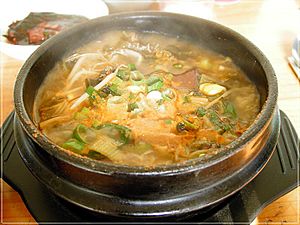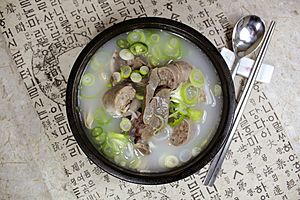Haejang-guk facts for kids

Seonji-guk, a type of haejang-guk
|
|
| Type | Guk |
|---|---|
| Place of origin | Korea |
| Korean name | |
| Hangul |
해장국
|
|---|---|
| Hanja |
解(*酲)-
|
| Revised Romanization | haejang-guk |
| McCune–Reischauer | haejang-kuk |
| IPA | [hɛ̝.dʑaŋ.k͈uk̚] |
Haejang-guk (해장국) is a special kind of soup from Korean cuisine. Its name means "soup to relieve a feeling of discomfort," and it is traditionally eaten to help people feel better.
This hearty soup often includes ingredients like dried napa cabbage, other vegetables, and meat. These are all cooked together in a rich beef broth.
Some types of haejang-guk have unique additions. For example, seonjiguk contains slices of a special ingredient made from congealed ox blood. Another type, sundaeguk, includes a kind of sausage made with pig's blood and other ingredients stuffed into intestine.
Contents
Exploring Different Types of Haejang-guk
There are many different kinds of haejang-guk. Each region in Korea has its own special recipe. These differences come from the ingredients they use and how they prepare the soup. This gives each type its own unique flavor.
Seoul-Style Haejang-guk
In the capital city of Seoul, haejang-guk is often a type of tojangguk. This means it is a soup made with soybean paste.
This Seoul version includes ingredients like bean sprouts, radish, napa cabbage, and scallions. It also has coagulated ox blood, all cooked in a rich broth. The broth is made by simmering ox bones in water for many hours. The neighborhood of Cheongjin-dong is very famous for this traditional Seoul-style haejang-guk.
Jeonju's Kongnamul Gukbap
In the city of Jeonju, people enjoy a dish called "kongnamul gukbap" as their haejang-guk. This dish uses small, lean bean sprouts that are gently cooked in lightly salted water.
To prepare it, steamed rice, sliced ripe kimchi, scallions, and garlic are placed in a small earthen pot called a ttukbaegi. Beef broth and a small amount of beef shank are added. Then, the bean sprout broth is poured over everything. As it boils, a raw egg is cracked into the soup. When served, diners can add extra flavor with sesame seeds, salt, minced garlic, chili pepper, and salted fermented shrimp.
Cold Haejang-guk Soups
Not all haejang-guk soups are served hot! Along the coast of the Sea of Japan, especially in Uljin County, people eat "ojingeo mulhoe guksu" as a cold haejang-guk.
This dish features finely sliced squid that looks like noodles. It's mixed with a special sauce, and then cold water and ice cubes are added. It's a refreshing way to enjoy this traditional soup.
Other Popular Types
Here are a few more types of haejang-guk you might find:
- Ugeojiguk (우거지국) - This soup is made with ugeoji, which are the outer leaves of napa cabbage.
- Seonjiguk (선짓국) - This type uses seonji, which is the coagulated ox blood mentioned earlier.
- Jaecheopguk (재첩국) - This soup is made with jaecheop (a type of small clam called Corbicula fluminea) and buchu (garlic chives).
- Gulgukbap (굴국밥) - This delicious soup is made with fresh oysters and buchu (garlic chives).
See also
 In Spanish: Haejangguk para niños
In Spanish: Haejangguk para niños


